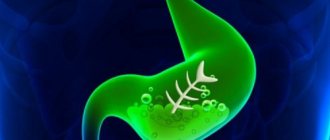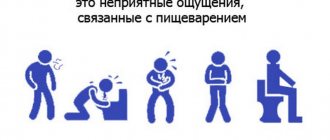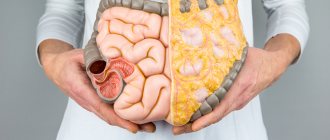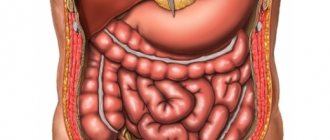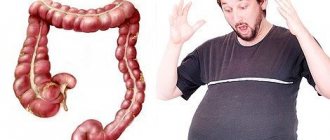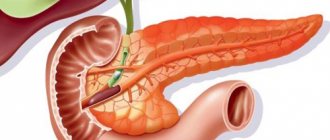Translated from Latin, the word “dyspepsia” means indigestion. This condition refers to pain and discomfort, a burning sensation in the upper abdomen, a feeling of fullness in the stomach and a feeling of premature satiety.
Dyspepsia is the most common problem in gastroenterology: up to 95% of all diseases of the gastrointestinal tract are manifested by dyspepsia syndrome. At the same time, patients in whom it is caused by organic reasons (some kind of gastrointestinal disease) make up only 40% of those who consult a doctor with similar complaints.
Classification and causes of dyspepsia
By origin, dyspepsia can be functional or organic. Organic dyspepsia is called dyspepsia, which accompanies diseases of the gastrointestinal tract:
- GERD;
- peptic ulcer of the stomach and duodenum;
- malignant neoplasms of the gastrointestinal tract;
- Helicobacter pylori infection;
- chronic pancreatitis;
- diseases of the biliary tract;
- celiac disease, syndrome of increased bacterial growth in the small intestine;
- irritable bowel syndrome.
Organic dyspepsia is associated either with a direct violation of the integrity of the gastrointestinal mucosa, which causes pain (ulcers, GERD, etc.), or with insufficient activity of digestive enzymes (pathology of the biliary tract, pancreatitis).
Functional dyspepsia is spoken of in cases where, after a thorough examination, it is not possible to detect any pathology of the gastrointestinal tract. Thus, this is a diagnosis of exclusion: it is never given to a patient who first comes to the doctor before laboratory and instrumental tests have been performed.
Gastric ulcer is a common cause of dyspepsia
This same subgroup often includes patients whose dyspepsia is caused by medications. Especially if they forget to tell the gastroenterologist about taking medications prescribed by other specialists. Drugs that can cause dyspepsia:
- anti-inflammatory drugs - traditional non-steroidal anti-inflammatory drugs (aspirin, ibuprofen, diclofenac) and cyclooxygenase-2 inhibitors (celecoxib, meloxicam);
- bisphosphonates - drugs for the treatment of osteoporosis (clodronate, tiludronate, etidronate);
- antibiotics;
- iron supplements;
- metformin;
- orlistat;
- ginkgo biloba preparations.
Often, functional dyspepsia occurs after an intestinal infection or with chronic stress.
Dyspepsia
Gastritis
Diabetes
Diarrhea
9031 12 November
IMPORTANT!
The information in this section cannot be used for self-diagnosis and self-treatment.
In case of pain or other exacerbation of the disease, diagnostic tests should be prescribed only by the attending physician. To make a diagnosis and properly prescribe treatment, you should contact your doctor. Dyspepsia: causes of occurrence, what diseases it occurs with, diagnosis and treatment methods.
Definition
The term dyspepsia is understood as a complex of disorders that indicate disruption of the normal functioning of the stomach and are accompanied by various symptoms that persist for 3 months in a row. Dyspepsia is manifested by pain or a feeling of heaviness (fullness) in the upper abdomen. Such discomfort may not be associated with food intake, but may be accompanied by nausea, bloating, heartburn, and belching.
Dyspepsia can be a symptom of various functional and organic disorders of the gastrointestinal tract, and if it occurs, consultation with a specialist is necessary.
Types of dyspepsia
There are many types of dyspepsia.
- Nutritional dyspepsia is the result of prolonged non-compliance with food intake rules and unbalanced nutrition. Nutritional dyspepsia has three subtypes:
- fermentative subtype - caused by excessive consumption of simple carbohydrates (sugars, flour products, fruits, legumes, etc.), fermented vegetables and fermented drinks (kvass, beer), as a result of which the balance of the intestinal microbiota shifts towards the fermentable flora;
- putrefactive subtype - caused by excessive consumption of protein foods (meat products and semi-finished products that require a lot of time to digest);
- fatty subtype - caused by excessive consumption of foods saturated with refractory fats (pork, lamb, etc.).
Causes of dyspepsia
Dyspepsia is the result of many pathological mechanisms. The appearance of a complex of symptoms characteristic of dyspepsia is caused in a quarter of cases by slower gastric emptying. In this case, pain and a feeling of heaviness are accompanied by vomiting and a significant decrease in appetite.
Some patients have increased sensitivity of the gastric and duodenal mucosa to stretching by food masses, which causes spasm of smooth muscles and pain.
In about a third of cases, the nervous system dysregulates the contraction of the stomach muscles, resulting in spasms that cause pain during stomach contractions.
Mild infections and indolent inflammatory lesions of the stomach and duodenum lead to the development of functional changes in the functioning of the digestive system. Various genetic factors predispose to the development of such dyspepsia.
Among the diseases that are accompanied by symptoms of dyspepsia, chronic gastritis and gastroduodenitis should be highlighted.
These diseases often occur in adolescence and young adulthood, when there is not enough time for proper and, importantly, regular nutrition.
There is a disruption in the production of mucus, which protects the gastric mucosa from mechanical and chemical influences (especially from hydrochloric acid, which is part of the gastric juice).
Dyspepsia is a constant companion to peptic ulcers of the stomach and duodenum. The symptoms of an ulcer are very varied and depend on its location in the wall of the organ.
Pain can occur after eating or, conversely, “hunger pain.” Other symptoms of dyspepsia due to peptic ulcers are belching, nausea or even vomiting after eating.
In recent years, the medical community has given increasing importance to
Helicobacter pylori (H. pylori)
. Damage to the gastric mucosa occurs when the vital activity of this bacterium increases and upsets the balance between protective and damaging effects. The bacterium is very resistant to the acidic contents of the stomach and can significantly damage the mucous membrane, including the development of ulcerative defects. If instead of a special course of eradication therapy (to destroy this bacterium) only symptomatic treatment is carried out, then in the autumn-spring period exacerbations of gastroduodenitis and gastric ulcer occur.
Along with infectious causes of dyspepsia, there are psychosocial factors in the appearance of unpleasant symptoms. Stress, depression and anxiety lead to disruption of the regulation of the correct rhythm and adequate volume of secretion of gastric contents.
The secretion of hydrochloric acid increases and the gastric mucosa is damaged.
Gastroesophageal reflux disease (GERD) is one of the common causes of dyspepsia symptoms. Patients feel a burning sensation in the lower chest, especially after eating and when bending down in a lying position.
Painful sensations arise due to the reflux of acidic and aggressive gastric contents into the esophagus, and the esophageal mucosa suffers.
In some cases, symptoms of dyspepsia may indicate the development of certain heart diseases. One of the most common causes of pain is the abdominal form of myocardial infarction.
Low blood pressure may accompany the classic symptoms of dyspepsia.
Symptoms arise due to the special location of the heart attack - on the lower surface of the heart, directly above the diaphragm and stomach.
Long-term and uncontrolled use of certain medications (for example, non-steroidal anti-inflammatory drugs) leads to an imbalance of gastric protective factors and aggression factors. Acid damages the unprotected mucous membrane with the formation of erosions and ulcers.
Predisposing factors for the development of symptoms of dyspepsia and gastrointestinal diseases:
- violation of diet (long breaks between meals);
- food “on the run”, dry;
- abuse of spicy, sour, spicy, fried foods;
- very hot or very cold food;
- smoking and alcohol abuse (especially strong drinks), coffee;
- diabetes;
- kidney disease;
- burns, massive injuries and other causes of severe pain.
Which doctors should I contact?
The appearance of symptoms of dyspepsia requires contacting a general practitioner: a therapist or a pediatrician. After the examination, the doctor will prescribe a set of instrumental and laboratory tests and, if necessary, refer you to a specialist. You may need to consult a gastroenterologist, surgeon, or cardiologist.
Diagnosis and examination when symptoms of dyspepsia appear
During the examination, it is possible to use both laboratory and instrumental research methods.
- Clinical blood test;
Symptoms of dyspepsia
Depending on which clinical manifestations predominate, epigastric pain syndrome and postprandial distress syndrome are distinguished.
Epigastric pain syndrome is diagnosed when the patient experiences pain or burning in the upper abdomen at least once a week. Pain may occur on an empty stomach and disappear after eating, or, conversely, appear after eating. It is not associated with defecation and does not go away after visiting the toilet.
Postprandial distress syndrome is a feeling of early satiety or heaviness in the stomach, a feeling of fullness. Both subtypes of dyspepsia can be combined with nausea and belching, as well as with each other.
Symptoms and treatment of intestinal dyspepsia in adults
Intestinal dyspepsia itself is a complex of symptoms, combining such manifestations as heartburn, heaviness in the stomach, nausea, flatulence (bloating), persistent constipation or diarrhea, pain in the abdomen and epigastric region.
In addition, each type of disorder has its own clinical manifestations:
- Fermentation. It manifests itself as unpleasant sensations in the epigastrium, a metallic taste in the mouth, nausea, loose frequent stools, and bloating. The patient’s sleep is also disturbed, headache, muscle weakness, and fatigue may occur.
- Fermentation. It occurs with bloating, pain in the abdomen (due to accumulating gases), frequent loose, foaming stools with a sour odor, and an unpleasant odor from the mouth.
- Fat. Characterized by diarrhea, discomfort and abdominal pain that occurs an hour after eating.
- Putrid. It manifests itself as diarrhea (stool has a putrid odor), nausea (often along with vomiting), intestinal colic, loss of appetite, symptoms of general intoxication of the body - weakness, headache, dizziness.
An urgent visit to a doctor is necessary in cases where unpleasant symptoms are accompanied by:
- weight loss;
- frequent vomiting, vomiting with bloody impurities;
- difficulty swallowing food;
- the presence of black, tarry stools;
- painful sensations in the chest;
- jaundice (yellowish discoloration of the skin and sclera);
- shortness of breath;
- increased sweating;
- general malaise.
All these symptoms indicate serious illnesses that require immediate treatment.
Diagnosis of the disease
To confirm the diagnosis, a visual examination and palpation of the abdomen (to detect bloating), an assessment of the patient’s complaints and concomitant diseases are performed.
Since dyspepsia is a collective symptom complex, all organs of the digestive system are examined to identify its causes.
The doctor can determine the causes of intestinal dyspepsia based on the results of the following laboratory and instrumental examination methods:
- urine and feces tests (allows you to detect hidden blood impurities, particles of undigested food, high fat content);
- general and biochemical blood tests (allows you to identify inflammatory processes in the body);
- gastric juice analysis (to clarify the acidity level);
- hormone tests (to identify diseases of the endocrine system, metabolic disorders);
- tests for Helicobacter pylori - bacteria that cause peptic ulcers of the stomach and duodenum;
- mannometric study (the level of gastrointestinal motility is assessed);
- endoscopy of the esophagus, intestines (for the diagnosis of gastritis, ulcers, duodenitis, benign/malignant neoplasms);
- Ultrasound of the abdominal organs, including the liver, gallbladder, pancreas;
- colonoscopy (detects the presence of cancer in the large intestine);
- contrast radiography (allows you to assess the condition of the esophagus, stomach, small and ileal intestines, identify hiatal hernia, malignant tumors).
X-ray examination is performed only if cancer is suspected. The procedure is contraindicated for pregnant and lactating women and small children.
Treatment of the disease
Treatment of the disease is carried out comprehensively, selected taking into account the reasons that caused the unpleasant symptoms, the severity of the pathological process, concomitant diseases and other individual characteristics of the patient.
Drug therapy is aimed at treating the underlying disease and eliminating unpleasant symptoms. As a rule, the standard therapeutic regimen includes the following groups of drugs:
- Antacids. They neutralize the acidic environment with increased production of hydrochloric acid in the stomach, thereby reducing irritation of the mucous membrane. Most often, antacids are prescribed based on aluminum phosphate (Phosphalugel), magnesium hydroxide (Alumag, Maalox), calcium and magnesium carbonate (Rennie), sodium bicarbonate and bismuth subnitrate (Vicalin, Vikair).
- Alginates. The action of the drugs is based on neutralizing the produced hydrochloric acid and pepsin, creating a protective film on the surface of the gastric mucosa (Gaviscon, Laminal).
- Drugs that suppress the production of hydrochloric acid in the stomach. This group includes histamine receptor blockers (Ranitidine, Famotidine) and proton pump inhibitors (Rabeprazole, Omeprazole, Pantoprazole).
- Antibiotics. If dyspepsia accompanies an ulcer caused by an infection, antibiotics of two groups (usually Clarithromycin and Amoxicillin) and proton pump inhibitors are prescribed.
- Preparations for normalizing stool. Drugs in this group (Loperamide, Furazolidone) are prescribed if dyspepsia is accompanied by diarrhea.
- Enzymes. Festal, Pancreatin, Pancreazym are prescribed, as a rule, for putrefactive dyspepsia and insufficient production of enzymes by the pancreas.
Diagnosis of dyspepsia
Diagnosis of dyspepsia comes down to identifying diseases that can cause this syndrome. If dyspepsia first appeared in a person over 45 years of age, oncological pathology must first be excluded. To do this, they do an endoscopy of the esophagus, stomach and duodenum, ultrasound of the abdominal cavity, and examine feces for occult blood. After these tests, other diseases that can cause dyspeptic syndrome can be detected.
To identify dyspepsia associated with Helicobacter pylori infection, tests are performed to identify the pathogen. This may include a breath test, a stool test for a bacterial antigen, or a blood test to test for antibodies to the bacteria. It should be noted that Helicobacter pylori infection can be excluded only if two different tests give a negative result, since their sensitivity is not one hundred percent.
In addition, in large clinics, to diagnose the condition of the stomach, they may prescribe pH-metry of the esophagus and stomach (study of acidity levels), electrogastrography to record the motor activity of the stomach, and other methods that can be considered as auxiliary.
Diagnostics
In order to determine the cause and treatment of dyspeptic symptoms, it is necessary to carry out certain comprehensive diagnostic measures.
Along this path, the patient will have to go through several specialists, starting with the therapist. This doctor decides where the patient should go next: a gastroenterologist, an infectious disease specialist, etc.
Taking into account the clinical features of the disease, the following manipulations may be prescribed:
- Taking blood for general analysis.
- Coprogram for determining the functioning of the pancreas.
- Analysis of exhaled air for the content of microorganisms.
- FEGDS.
- Ultrasound of the abdominal organs.
- Study of the performance of the liver, gall bladder and all other organs of the digestive tract through a biochemical blood test.
- Application of radiography.
- Colonoscopy.
- Tomography.
- Examination of stool for parasite eggs.
Treatment of dyspepsia
All patients with dyspepsia are recommended to eat split meals - 5-6 times a day in small portions. It is necessary to keep a food diary to identify foods that worsen the condition. It could be coffee, garlic, fatty or spicy foods - nutritional factors are largely individual. A complete cessation of smoking and alcohol is recommended.
Drug treatment of dyspepsia will depend, first of all, on the underlying pathology.
Thus, when Helicobacter pylori is detected, a complex of proton pump inhibitors (drugs that reduce the synthesis of hydrochloric acid by the stomach) and two or three types of antibiotics are recommended.
If the cause of dyspepsia is an ulcer or GERD, therapy begins with proton pump inhibitors (omeprazole, lansoprazole, pantoprazole). As an alternative to PPIs, you can use drugs from the group of H2-blockers (ranitidine, famotidine), these are also antisecretory drugs. They can quickly relieve symptoms, but treatment cannot be limited to this - PPIs and H2 blockers only temporarily reduce the production of hydrochloric acid.
For dyspepsia, frequent split meals are prescribed
The treatment of peptic ulcers and GERD is based on gastroprotectors (rebagitis). They increase the effectiveness of eradication (elimination) of Helicobacter pylori, the main cause of ulcers, and restore the integrity of the mucous membrane of the gastrointestinal tract along its entire length, at all three structural levels. Gastroprotectors are also indicated for dyspepsia caused by taking medications, especially non-steroidal anti-inflammatory drugs.
If signs of postprandial distress syndrome predominate among the symptoms of dyspepsia, prokinetics are recommended - drugs that normalize gastrointestinal motility: domperidone, trimebutine, itopride hydrochloride.
For enzyme deficiency, medications containing pancreatic enzymes are recommended.
For functional dyspepsia, pharmacotherapy also begins with proton pump inhibitors and gastroprotectors (the latter to eliminate possible microdamage and microinflammation, as well as normalize the structure of the mucous membrane). As second-line drugs, drugs that normalize the state of the nervous system are prescribed: tricyclic antidepressants or serotonin reuptake inhibitors. These drugs are usually recommended in subtherapeutic doses—less than those used to treat depression.
What is intestinal dyspepsia
This is a collective concept that combines various symptoms of disorders of the gastrointestinal tract. Nausea, flatulence, abdominal and epigastric pain are the main manifestations that occur with diseases of the gastrointestinal tract or are a consequence of poor nutrition.
It will be possible to completely get rid of unpleasant symptoms only if the exact cause of the indigestion is determined.
Intestinal dyspepsia accompanies diseases of the digestive system, including pathologies:
- intestines (gastroenteritis and other infectious diseases, dysbacteriosis);
- stomach and small intestine (gastritis, duodenitis, ulcer, gastroesophageal reflux, gastroparesis, chronic intestinal ischemia);
- pancreas (cyst, cystic fibrosis, pancreatitis, pancreatic necrosis);
- bile ducts and bladder, liver (cholangitis, gallstones, cholecystitis, cirrhosis, hepatic vein thrombosis, hepatitis);
- paraesophageal, diaphragmatic hernia;
- intestinal obstruction;
- oncological diseases of the gastrointestinal tract;
- food allergies.
The cause of the disorder can be severe poisoning (domestic or industrial), as well as intoxication that develops as a result of a purulent inflammatory process occurring in the body.
The risk of developing digestive disorders increases with:
- systemic pathologies (diabetes mellitus, thyroid disease, chronic renal and heart failure);
- metabolic disorders, obesity;
- non-compliance with diet, constant overeating, abuse of fatty, fried, spicy foods, monotonous diet;
- regular and long-term use of certain medications (non-steroidal anti-inflammatory, antibacterial, antihypertensive and other drugs);
- constant nervous overstrain, prolonged stress;
- alcohol abuse;
- sedentary lifestyle.
Forecast and prevention of dyspepsia
Dyspeptic syndrome is not life-threatening unless it is a consequence of cancer or peptic ulcer disease. With functional dyspepsia, in about a third of patients, symptoms disappear within a year. For the rest, the symptoms of dyspepsia persist for a long time, sometimes intensifying and sometimes weakening.
There is no specific prevention of dyspepsia. A healthy lifestyle, proper nutrition, giving up bad habits and stress management skills will help reduce the likelihood of this syndrome.
1 E.A. Lyalyukova. Dyspepsia syndrome in the practice of a general practitioner and general practitioner. Gastroenterology, 2021.
2 A.N. Belovol, I.I. Knyazkova. Dyspepsia in the practice of a therapist. Mystetstvo Likuvannya (The Art of Healing), 2011.
The main reasons for the development of the disease
Dyspeptic syndrome is associated with digestive disorders at one of the stages:
- In the mouth, food is moistened with saliva, and its enzymes begin the process of breakdown.
- In the stomach, hydrochloric acid produced by glands helps digestion.
- In the duodenum, digestive enzymes from the pancreas and intestinal mucosa break down proteins, fats and carbohydrates.
- Bile acids help fats mix with digestive juices.
It is malfunctions in the digestive system at any of these stages that are the cause of dyspeptic syndrome.
The secretory and motor work of organs is regulated by the parasympathetic nervous system, the vagus nerve, which is why the incidence increases against the background of stress.
The causes of the disorders can be both head injuries and previous respiratory tract infections, since the nerve passes to the internal organs from the skull along the outer surface of the chest.
Irregular diet and concomitant diseases also increase the likelihood of inflammatory processes.
Development against the background of organic disorders
Dyspeptic syndrome develops against the background of the following organic pathologies:
- Peptic ulcer disease manifests itself as pain in the upper abdomen in the epigastric region, as well as in the right or left upper quadrants. Pain from ulcers occurs 2-5 hours after eating or on an empty stomach, but peptic ulcers cause attacks after eating certain foods. Symptoms include belching, early satiety, fat intolerance, nausea, and sometimes vomiting.
- Biliary disorders are characterized by attacks of intense dull pain in the right hypochondrium, epigastrium or behind the sternum with reflection under the right scapula. Attacks that are cramping in nature are associated with intense sweating, nausea and vomiting. The pain is not aggravated by movement and is not relieved after defecation and passing of gas, lasts at least 30 minutes, gradually subsiding over 6 hours.
- Drug-induced dyspepsia appears after non-steroidal anti-inflammatory drugs and selective COX-2 inhibitors without peptic ulcer. Symptoms are also provoked by calcium channel blockers, methylxanthines, alendronate, orlistat, potassium supplements, erythromycin.
- Celiac disease and chronic pancreatitis rarely accompany dyspepsia, as do other diseases: eosinophilic gastroenteritis, Crohn's disease, sarcoidosis, lymphoma, amyloidosis, diabetic radiculopathy, heavy metal poisoning.
Development without organic disturbances
Predisposing factors for functional dyspepsia are:
- infection with Giardia and helminths;
- allergies and diathesis, prolonged inflammation;
- hypovitaminosis, iron deficiency anemia, especially with a lack of B vitamins;
- irregular eating, overeating, abuse of fast food and sweets, alcohol and smoking;
- psycho-emotional disorders due to stress, lack of sleep, which causes blockage of the vagus nerve, spasm of the diaphragm, ligaments of the stomach, liver and pancreas, indigestion in the dyspepsia syndrome.
Chemical disorders often cause dyspeptic syndrome. Food processing is inhibited by: lack of enzymes in saliva, pancreas, intestines or stagnation of bile. Behind every chemical disorder is insufficient blood supply or innervation of the organ.
The vagus nerve and arteries pass to the stomach through the diaphragm, and its spasms often occur during times of stress. Poor blood flow to the organ provokes gastritis with high acidity, poor appetite, and constipation. A “nutrient” environment is formed for the development of bacteria, inflammatory reactions, and allergies.
On the other hand, dysentery and viral enteritis, which disrupt intestinal function, can disrupt the functioning of the stomach. For example, salmonellosis infection also manifests itself as toxic dyspepsia, which provokes years of persistent dysbiosis, bloating and pain.
Diagnosis of pathology
Diagnosis requires interaction between a therapist and a gastroenterologist.
The doctor examines and evaluates pain in the epigastrium to identify inflammation in the internal organs. Local pain when the abdominal muscles are tense indicates a problem in the abdominal wall (abdominal muscles, fascia, diaphragm), and when relaxed, it indicates gastritis.
The doctor asks about tachycardia and arrhythmia, pallor and increased sweating, frequency and color of stool, appetite and weight loss or gain to identify other functional disorders of nearby organs.
Palpation of the abdomen determines the enlargement of organs, examines the color of the skin and whites of the eyes for jaundice.
A tendency to organic dyspepsia is determined against the background of gastritis and other diseases.
Hunger and night pain, heartburn and “sour” belching are indications for assessing the condition of the inner surface of the stomach. X-rays are prescribed if a peptic ulcer is suspected. A blood test is performed for H. Pylori.
If there is no inflammation in the digestive organs, then the gastroenterologist identifies functional dyspepsia. Ultrasound evaluates the function of the gallbladder, and duodenal intubation determines the composition of bile. Additionally, a blood test is done for protein, bilirubin, and alanine aminotransferase.
The work of the gastrointestinal tract is closely related to the kidneys and genitourinary system, therefore the examination includes a urine test.
In case of diarrhea and flatulence, rashes are sent for stool examination to determine giardiasis and helminthiasis.
Differential diagnosis excludes malabsorption syndrome and lactose intolerance.
